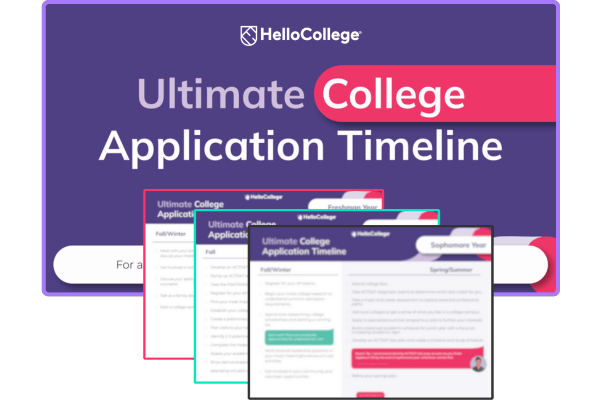Ultimate College Application Timeline: Your FREE Guide
Have you been wondering, “What’s the timeline for applying to college?” While you’ll submit your applications during senior year, it’s never too early to start preparing. Even if deadlines feel far away, planning ahead is the best way to stay organized and avoid missing important steps. We know managing the college planning timeline can feel overwhelming, but don’t worry—we’ll guide you through the process, from freshman year to senior year, with our Ultimate College Application Timeline.

Filll the Form Below to Download FREE Printable Version of the College Application Timeline
The Ultimate College Application Timeline
We’ve put together an in-depth college application timeline with a handy checklist of must-do tasks for every grade level, from freshman to senior year. In this timeline, you’ll find application tasks that include financial aid, college applications, extracurricular activities, and more.
To help visualize your entire college admissions journey, download our Ultimate College Application Timeline.
→ Freshman Year
Fall
- Meet with your counselor. One of the first things we recommend doing is meeting with your school counselor or guidance counselor (according to data, a high school student spends only 38 minutes with their school counselor throughout 4 years of their school). We recommend meeting with a dedicated and private college admissions consultant. Doing so will save you a lot of time and stress in the long-run. While you can certainly schedule your classes and research schools and academic requirements yourself, a counselor is an expert at scheduling high school classes and planning for college.
- Talk as a family about paying for college.
- Start a college savings plan.
- Sign up for a variety of extracurriculars to explore activities you enjoy.
- Start a document to track extracurricular activities and awards.
- Sign up for a variety of extracurriculars to explore activities you enjoy. Try out a few different extracurricular activities at your new school. Doing so will help you figure out your passions and give you the chance to fill your schedule with different activities that will look great on your college application. You could join sports teams, debate clubs, perform community service, or even take up an instrument. Try out a bunch of extracurriculars to find an activity that you truly enjoy.


Spring/Summer
- Evaluate your academic performance to see if you need help maintaining a strong GPA. After freshman year, see how you’ve done academically. Are the courses you chose the right fit? Would you benefit from academic tutoring or extra help next year? You want to make sure your GPA stays consistently high throughout your academic career. Consider all of this as you plan your sophomore schedule.
- Focus on and invest in the extracurriculars that most interest you.
- Apply for pre-college programs, volunteering, or summer jobs.
- Build a balanced schedule for sophomore year, considering honors and/or AP classes. You can sign up for AP classes and other advanced classes as soon as freshman year (depending on your school). We recommend starting one or two AP classes during your sophomore year. Then, junior year, consider taking up to four as you prepare for AP tests. Taking these advanced classes can be a real challenge, but they will boost your college application and give you an edge over other students.
- Begin career exploration with your school counselor.

Download a FREE Printable Version of the College Application Timeline
Get an easy-to-follow roadmap you can save, print, and refer to anytime—our free PDF timeline will keep you on track from start to finish.
→ Sophomore Year
Fall
- Register for your AP exams.
- Begin your initial college research to understand common admission requirements.
- Spend time researching college scholarships and starting a running list. If scholarships are important to funding your college journey, you should begin exploring scholarship opportunities early. While many scholarships open senior year, there are several strong opportunities you can apply for as early as 9th or 10th grade. Additionally, you may want to do a particular task with a particular organization or aim for a certain number of volunteer hours for those you can apply for in 11th or 12th grade. Be sure to note any requirements that you’ll need to meet, such as GPA as well. Academic scholarships will help you fund your college dreams, but you definitely need to do some research to see which scholarships you qualify for.
- Get involved in your community and volunteer opportunities.
- Work towards leadership positions in your most meaningful extracurricular activities. Consider which organizations you’re involved in where you can consistently participate and begin demonstrating your potential for a leadership role.


Spring/Summer
- Attend college fairs.
- Take ACT/SAT diagnostic exams to determine which test is best for you. The ACT and SAT are important parts of the college planning process. Most people take these exams during their junior year. But, we recommend learning about the structure of these tests and studying for them as soon as your sophomore year. There are tons of online classes, prep books, and other materials that can help prepare you for either exam. For the best results, look into hiring a one-on-one test prep tutor to target specific areas for improvement.
- Take a major and career assessment to explore potential professional paths.
- Visit local colleges to get a sense of what you like in a college campus.
- Apply to specialized summer programs or jobs to further your interests.
- Build a balanced schedule for junior year with a focus on increasing academic rigor.
- Develop an ACT/SAT study plan.
- Refine your savings plan.

Download a FREE Printable Version of the College Application Timeline
Get an easy-to-follow roadmap you can save, print, and refer to anytime—our free PDF timeline will keep you on track from start to finish.
→ Junior Year
Fall
- Develop an ACT/SAT test plan and register for 2–3 official exams to complete testing by the end of junior year. Register and take your SAT or ACT exams. While some students may test earlier, most students should take these exams in fall and spring of junior year, so your scores are completed in time for your college applications.
- Ramp up ACT/SAT test prep with consistent studying and regular practice exams. Enroll in test prep classes, use SAT prep books, and take practice tests as often as possible. Plan to go to prep classes, read books, create flashcards, and do other preparation as you study.
- Take the PSAT/NMSQT in October to qualify for the National Merit Scholarship. Take the PSAT for a bit of additional practice and as the only opportunity to compete for National Merit Scholarships. Your PSAT in 10th grade will not count for National Merit, but this one in 11th grade is specifically called the NMSQT—the National Merit Scholarship Qualifying Test.
- Register for your AP exams.
- Pick your most important college factors based on social, academic, financial, and environmental fit.
- Establish your college budget parameters.
- Build a preliminary college list of 15–20 schools.
- Plan visits to your top colleges throughout the rest of junior year. Start visiting more college campuses to get a feel for different schools and narrow down your choices. This is the perfect time to ask questions, see what campus life is like, and figure out which school will be the best academic and social fit!
- Identify 2–3 potential career paths and majors of interest.
- Complete the FAFSA Forecaster to find out what type of aid you may qualify for.
- Assess your academic progress with your counselor and make adjustments if needed.
- Show demonstrated interest in your favorite schools by emailing admissions, following social media accounts, and attending virtual/in-person events.


Spring
- Maintain your normal test prep schedule (as needed).
- Apply to specialized summer programs, research positions, or job shadowing opportunities.
- Compare costs of the schools on your list.
- Attend college informational sessions and talk to reps visiting your school.
- Invest more time researching scholarships for which you qualify.
- Build a balanced schedule for senior year, prioritizing APs and classes aligned with your intended college major.
- Narrow down your college list to 8–12 schools. Use our SAFE College Fit Guide to evaluate the colleges on your list based on social, academic, financial, and potential employment fit. This approach ensures you look beyond rankings and prestige to make a well-informed decision based on what truly matters.
- Identify and ask 2 teachers to write letters of recommendation.
- Start brainstorming ideas for your Common App personal statement.
- Register for summer ACT/SAT (if needed).
Summer
- Draft and finalize your Common App Personal Statement. Your personal statement is your best opportunity to showcase who you are as a person beyond the stats on a page. As a result, you want to spend a decent amount of time brainstorming, drafting, and editing it. Also, you’ll want to enlist some help—consider asking a teacher or family member for feedback, or hire a professional essay coach to help you navigate the entire process. Since most schools use a holistic review process, a strong personal statement can really help tip the scales in your favor.
- Begin strategizing your college-specific supplemental essays.
- Continue visiting colleges on your list.


Download a FREE Printable Version of the College Application Timeline
Get an easy-to-follow roadmap you can save, print, and refer to anytime—our free PDF timeline will keep you on track from start to finish.
→ Senior Year
August
- Finalize your Common App personal statement.
- Create a spreadsheet of supplemental essays and begin writing.
- Research Early Decision, Early Action, and Regular Decision deadlines for your schools. It’s important to understand the types of college admissions. Early Action (EA) lets you apply early (usually by November 1 or 15) and get an early decision, but it’s non-binding, so you don’t have to commit. Early Decision (ED) is binding—if accepted, you must attend. Some schools offer ED II, which has a later deadline but the same commitment. Regular Decision (RD) has later deadlines (December or January).
- Create a spreadsheet with admissions and financial aid deadlines.
- Continue challenging yourself academically and maintaining your GPA.
- Check on letters of recommendation from your teachers.
- Create your Common Application account and begin filling out information.
- Work on college-specific applications (i.e. ApplyTexas, UC).


September
- Meet with your counselor to develop a college application strategy.
- Meet with school reps who visit your high school and participate in informational nights and college fairs.
- Attend college planning and/or financial aid information sessions.
- Contact colleges’ financial aid offices to determine which forms they require.
- Ask for final letters of recommendation.
- Set up your FSA IDs and prepare to complete FAFSA as early as October 1st.
- Complete supplemental essays.

Download a FREE Printable Version of the College Application Timeline
Get an easy-to-follow roadmap you can save, print, and refer to anytime—our free PDF timeline will keep you on track from start to finish.
October
- Complete your FAFSA online to determine your financial aid eligibility.
- Make official visits to your top school choices.
- Ensure your teachers and guidance counselor send letters of recommendation.
- Complete and submit Early Action and Early Decision applications by their deadlines.
November
- Complete applications for college-specific scholarships for which you may be eligible.
- Stay focused on your schoolwork.
- Work on Regular Decision applications.
December
- Finalize and submit Regular Decision admission applications.
- Submit your UC applications by the deadline.
- Watch your email for early admissions decisions.
- If accepted Early Decision, withdraw your applications to other schools.


January
- Write Letters of Continued Interest to schools where you were deferred or waitlisted.
- Research and apply for independent and local scholarships.
- Research and apply for summer jobs and internships.
February
- Maintain your grades for your mid-year report. Even after submitting applications—or even getting accepted—you can’t afford to slack off. Most colleges request a mid-year report to help with admissions decisions or to ensure admitted students stay on track academically.
- Submit school-specific and independent scholarship applications.
March
- Rank your top school choices based on acceptances.
- Compare financial aid award offers.
- Narrow down your final college choices and make any last visits.
April
- Negotiate financial awards and submit letters of appeal as necessary.
- Make your final school decision and enrollment deposit by May 1st. Now, it’s time to weigh your options! Once you hear back from the schools you’ve applied to, you’re ready to take the next big step toward a college career. Take a look at the financial aid offers you’ve received and evaluate the options. Be sure to factor in your academic goals, social needs, and other preferences before making a final decision.
- Notify the schools you have chosen not to attend.
- Note registration, orientation, and housing dates.
May/June
- Sign up for summer orientation sessions at your college choice.
- Finalize your summer job plans.
- Prepare a student budget.
- Ensure your high school sends your final transcript to your college after graduation.
- Request college transcripts for any dual credit courses you took in high school to receive college credit.


Download a FREE Printable Version of the College Application Timeline
Get an easy-to-follow roadmap you can save, print, and refer to anytime—our free PDF timeline will keep you on track from start to finish.
Explore Related Free Resources
College visits are one of the most exciting parts of figuring out which school will be the best fit for you. With so many different options and so much to explore it can be overwhelming to plan your trip, especially when there’s so much to do and so many questions to ask. Here’s a checklist to help.
With the Stand Out Factor Workbook, you’ll be able to better understand what sets you apart from other applicants—and develop a plan to broadcast those unique qualities to college admissions officers.
Choosing the right college is important because this decision will impact many areas of a student’s life for at least the next four years, from academics to social activities. Therefore, it’s very important to carefully consider this decision.
